Florida’s extraordinary butterfly diversity – with over 200 species including many found nowhere else on Earth – makes it an ideal location for creating spectacular butterfly gardens. However, successful butterfly gardening requires understanding that these delicate creatures need more than just pretty flowers. In the Sunshine State, they need native Florida butterfly plants to thrive.
To attract these delicate creatures, your butterfly garden must provide food for both the adult butterflies and their caterpillars. Though many butterflies will drink nectar from a variety of flowering plants, their caterpillars are often limited as to which plants they can feed on.
The key to butterfly garden success lies in providing four essential components: adult nectar sources to nourish visiting butterflies, larval host plants where females can lay eggs and caterpillars can feed, shelter from weather and predators, and consistent water sources. A wide assortment of flowers is better than having just a few kinds.
Butterflies are attracted to brightly colored, simple flowers with good places to perch. To make sure that nectar is always available, choose your flowers so that something is always in bloom.
Why Add Native Florida Butterfly Plants to Your Pollinator Garden?
Native plants form the foundation of effective butterfly gardens because most larval host plants are natives. They’re adapted to the region, will produce a small but representative extension of the natural ecosystem, and can attract other wildlife.
Native Florida butterfly plants offer practical benefits too – they’re typically hardier, more drought-tolerant, and better adapted to Florida’s challenging conditions than non-native alternatives.
Design principles for butterfly gardens emphasize diversity in multiple dimensions. Choosing plants that have different heights and growth habits creates numerous microclimates which in turn appeal to a greater number of butterfly species; provides shelter; creates levels/strata of feeding opportunities.
Color variety is equally important since different butterfly species are attracted to different flower colors, so include yellow, orange, white, and blue flowers as well as reds, pinks, and purples.
- Our polyresin hand painted puddling stone is a beautiful way to create your own mineral puddle to attract beautiful butterflies to your garden.
- Metal Bee Feeder for Garden:the bee feeder becomes an uncomplicated addition to your garden toolkit, Compared with hanging bee feeders, our standing bee feeder for outside is more stable, will not shake even in bad windy weather. Upgraded the 4-pin ground plug for greater stability and reliability
31 Fabulous Native Florida Butterfly Plants to Attract Pollinators
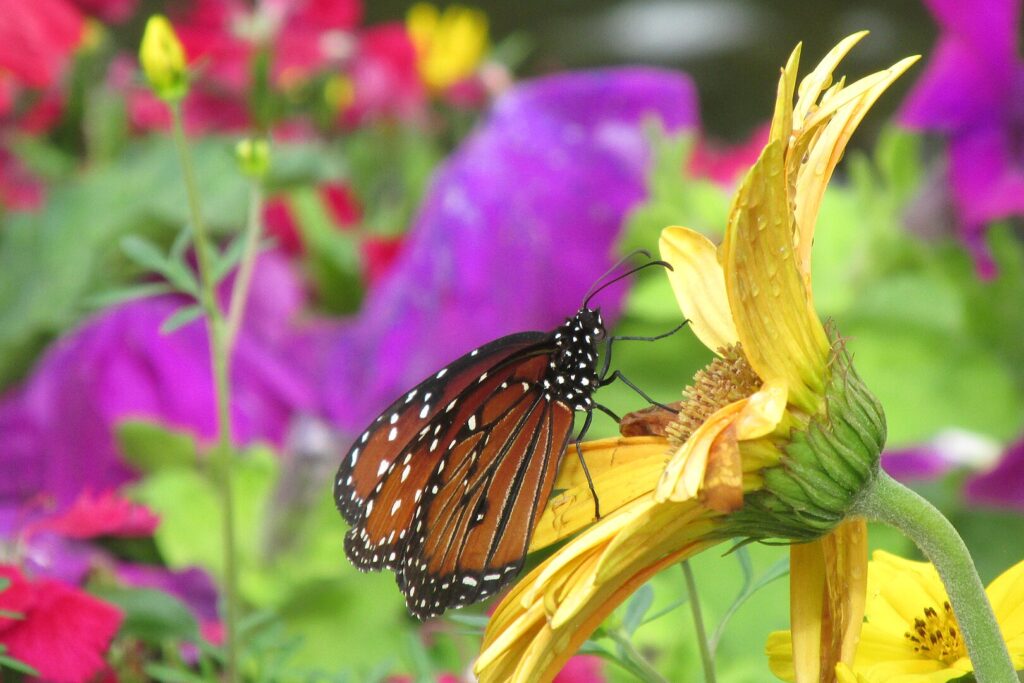
The plants featured in this guide represent Florida’s finest native species for butterfly gardens, each chosen for its proven ability to support butterfly life cycles while creating beautiful, functional landscapes.
From the essential milkweeds that serve as monarch nurseries to the continuous-blooming nectar sources that sustain adult butterflies year-round, these plants will transform your garden into a thriving ecosystem that supports both butterflies and the broader web of life they inhabit.
Remember that butterfly gardens embrace a slightly wilder aesthetic than traditional landscapes. A well-planned butterfly garden becomes a small, but representative sample of the surrounding habitat and as such provides a safe haven for butterflies and other wildlife to gather, seek shelter, acquire food and water, reproduce, and build populations
Do not underestimate the importance of even a small garden. Every butterfly garden, regardless of size, contributes to conservation efforts while providing endless opportunities for observation, photography, and connection with Florida’s remarkable natural heritage.
1. Aromatic Aster (Symphyotrichum oblongifolium)
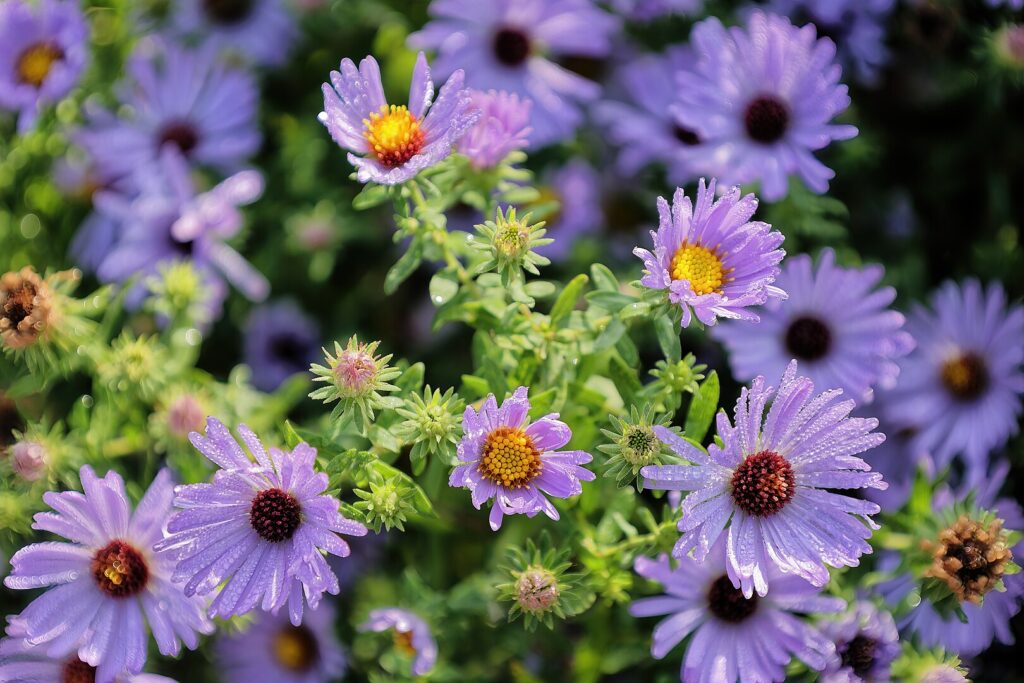
The Aromatic Aster brings late-season color to butterfly gardens with its dense clusters of small, lavender-blue flowers that bloom from September through November. This hardy perennial forms spreading mounds 2-4 feet tall and 3-5 feet wide, with narrow, aromatic leaves that release a pleasant fragrance when brushed.
Native to prairies and open woodlands, it thrives in well-drained soils and full sun to partial shade.
The flowers serve as crucial late-season nectar sources for migrating monarchs, painted ladies, and various skippers.
Its spreading habit makes it excellent for naturalizing in wildflower meadows or as a colorful fall border. Plant it alongside other fall bloomers like blazing stars for extended seasonal interest.
2. Black-eyed Susan (Rudbeckia hirta)
Black-eyed Susan is perhaps the most recognizable wildflower in Florida, producing cheerful golden-yellow petals surrounding dark chocolate centers from spring through fall.
This annual to short-lived perennial grows 1-3 feet tall and 1-2 feet wide, forming clumps that readily self-seed. Found naturally in prairies, roadsides, and disturbed areas throughout Florida, it adapts to various soil conditions but prefers full sun and good drainage.
Rudbeckia blooms attract numerous butterflies including Gulf fritillaries, painted ladies, and skippers, while the seeds provide food for goldfinches and other songbirds.
Its long blooming period and cheerful appearance make it perfect for cottage gardens, meadow plantings, or as a reliable filler in mixed borders.
3. Southern Blue Flag Iris (Iris virginica)
Blue Flag Iris adds elegant vertical structure to butterfly gardens with its sword-like foliage and stunning blue-purple flowers that bloom in late spring. This moisture-loving perennial grows 2-3 feet tall and 1-2 feet wide, forming clumps that gradually expand.
Native to wetlands, marshes, and pond edges throughout Florida, it requires consistently moist to wet soils and tolerates both full sun and partial shade.
While primarily attracting hummingbirds, the flowers also provide nectar for larger butterflies like swallowtails.
The dramatic foliage provides excellent textural contrast in rain gardens, pond margins, or boggy areas. Plant it with other wetland natives like swamp milkweed and cardinal flower for a stunning water garden display.
4. Blue Mistflower (Conoclinium coelestinum)
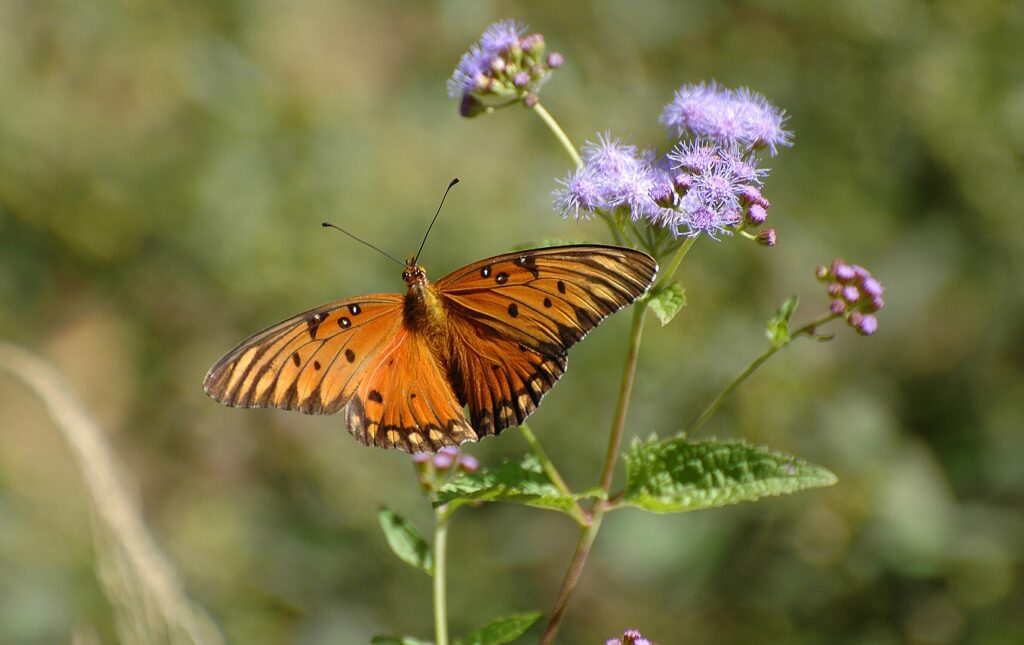
Blue Mistflower creates clouds of fuzzy, powder-blue flowers from late summer through fall, forming dense colonies 1-3 feet tall and spreading indefinitely by underground rhizomes.
This aggressive perennial thrives in moist soils and partial shade, naturally occurring in floodplains, stream banks, and wet woodlands.
The flowers are magnets for butterflies, especially monarchs, skippers, and sulphurs, serving as a critical late-season nectar source.
Its spreading nature makes it ideal for naturalizing in wild areas or controlling erosion along water features. In formal gardens, contain it with edging or plant it where its aggressive spread is welcome. Combine with other fall bloomers like aromatic aster for extended butterfly activity.
5. Blue Porterweed (Stachytarpheta jamaicensis)
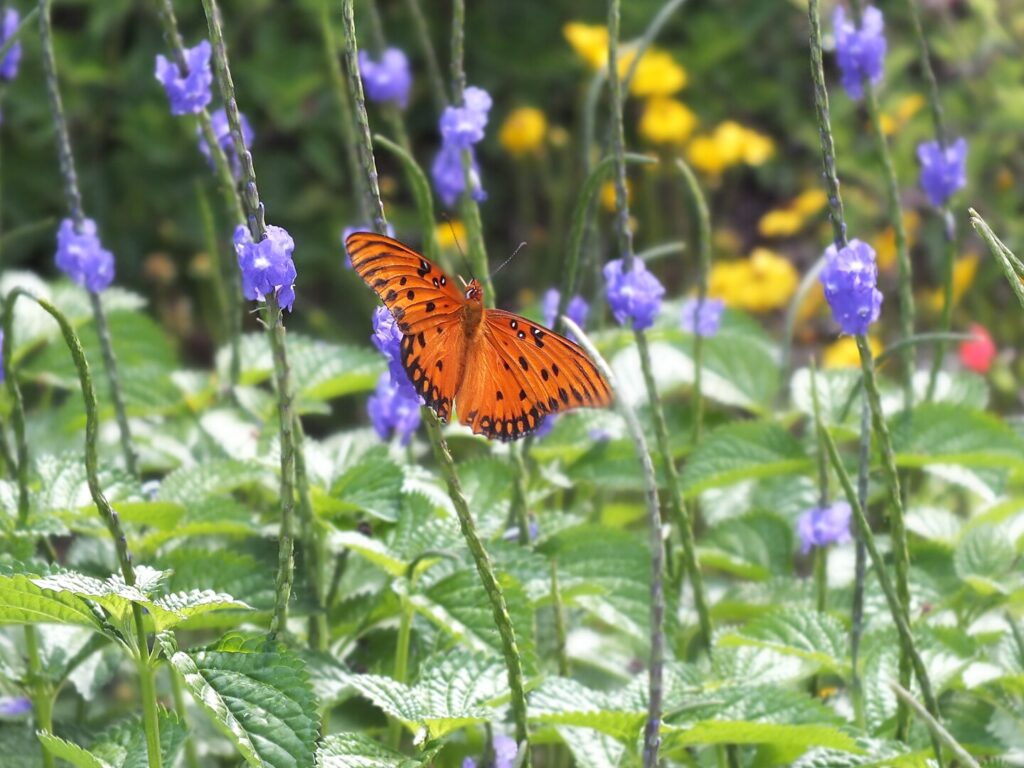
Blue Porterweed produces spikes of small, tubular blue flowers nearly year-round in South Florida, making it an invaluable continuous nectar source. This sprawling perennial grows 3-4 feet tall and wide, with a somewhat weedy but charming appearance.
Native to disturbed areas, roadsides, and forest edges, it thrives in poor soils and full sun to partial shade.
The flowers are especially attractive to long-tongued butterflies like longwings and swallowtails.
Its informal growth habit works well in naturalized areas, wildlife gardens, or as a background planting. Regular pruning helps maintain a tidier appearance. Plant it in areas where its self-seeding tendency is welcomed, as it provides consistent food for butterflies when other plants aren’t blooming.
6. Blue Sage (Salvia azurea)
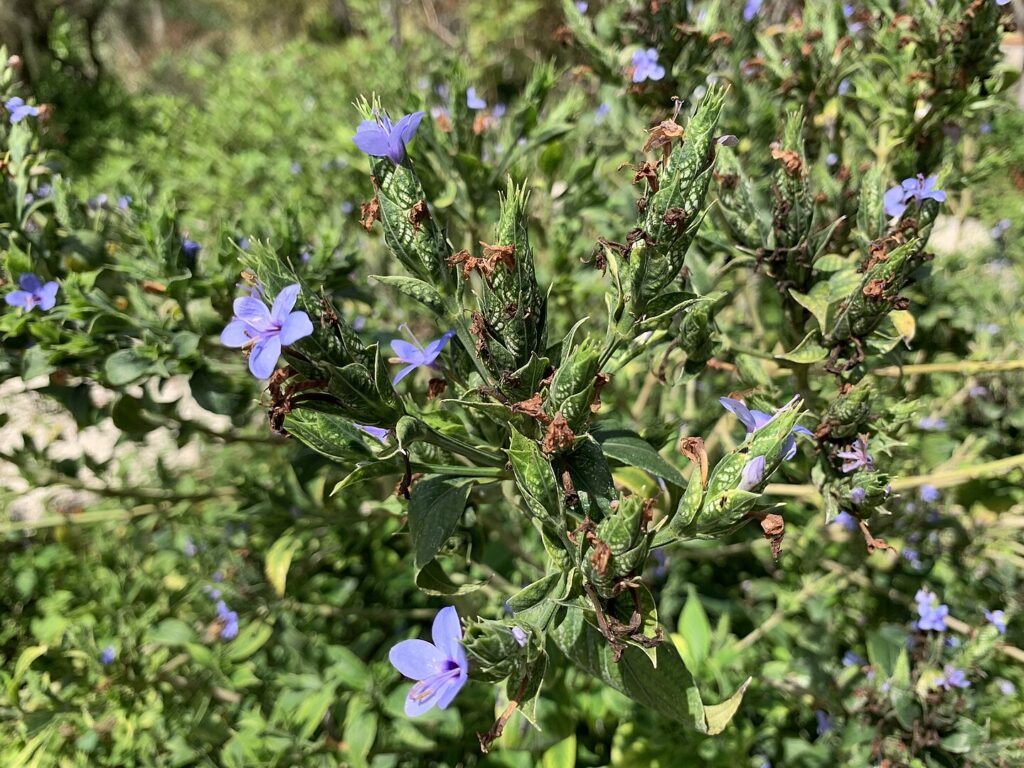
Blue Sage creates stunning spikes of clear sky-blue flowers from late summer through fall, reaching 3-6 feet tall and 2-3 feet wide. This upright perennial has narrow, gray-green leaves and an airy, graceful form that sways beautifully in breezes.
Native to prairies and open woodlands, it prefers well-drained soils and full sun. The tubular flowers attract long-tongued butterflies like skippers and provide nectar for hummingbirds.
Its height and late-season bloom make it perfect for the back of borders or as a naturalized planting. The spikes create excellent cut flowers and the plant self-seeds readily. Combine with other tall prairie plants like blazing stars for a stunning autumn display.
7. Butterfly Weed (Asclepias tuberosa)
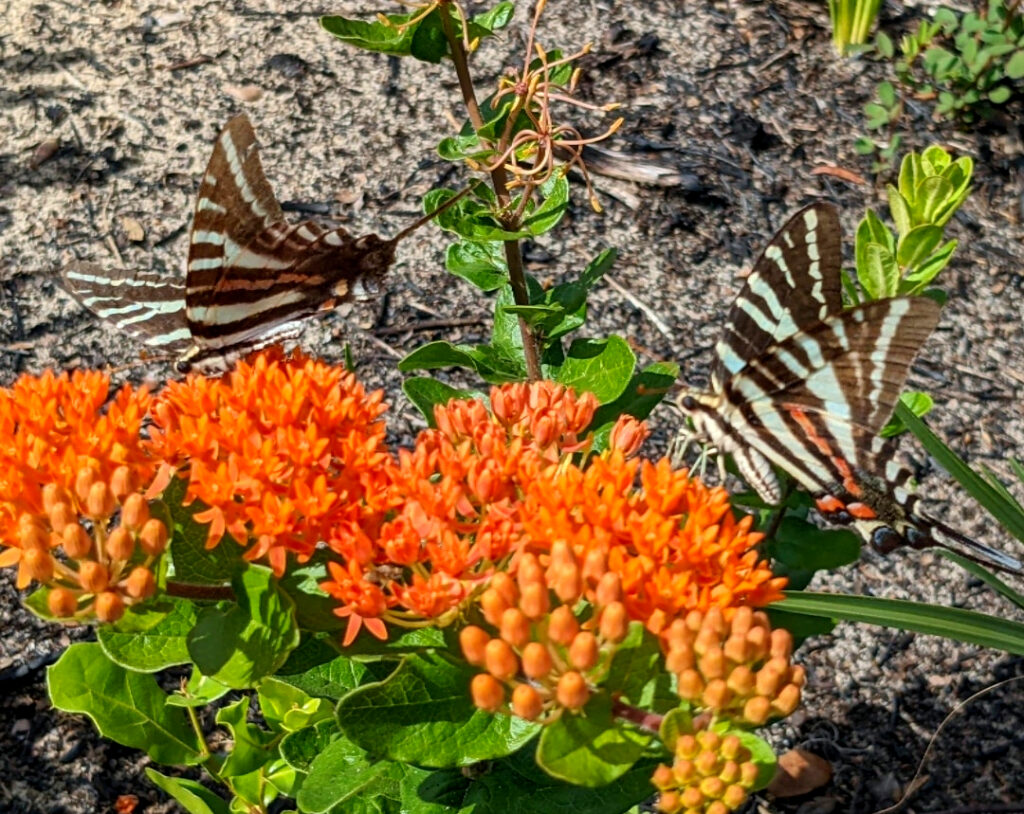
Butterfly Weed brings a splash of fiery color to prairies, meadows, and gardens, producing flat-topped clusters of brilliant orange flowers from spring through fall. This drought-tolerant perennial flower grows 1-3 feet tall and 1-2 feet wide, with narrow, lance-shaped leaves and a deep taproot.
Florida has two subspecies: A. tuberosa ssp. rolfsii is less bushy, has wavy leaf margins, and occurs throughout Florida. A. tuberosa ssp. tuberosa has flatter, narrow leaves and is often found in woodlands in northern Florida. Native to sandy soils, pine flatwoods, and prairies, it thrives in well-drained conditions and full sun.
This is the primary host plant for monarch butterflies, where they lay eggs and caterpillars feed exclusively on the leaves. The flowers also attract numerous other butterflies, bees, and beneficial insects.
Plant it in masses for maximum impact, and remember that monarch caterpillars may defoliate plants – this is normal and beneficial. Its deep taproot makes it difficult to transplant, so choose the location carefully.
8. Carolina Jessamine (Gelsemium sempervirens)
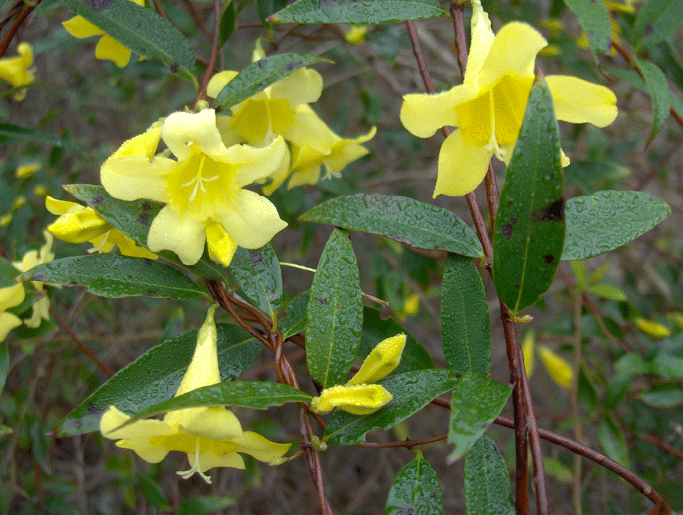
Carolina Jessamine is a vigorous evergreen vine that produces masses of fragrant, bright yellow trumpet-shaped flowers in early spring. This climbing vine can reach 20 feet or more, with glossy, dark green leaves that provide year-round structure.
Native to woodland edges, fencerows, and disturbed areas throughout Florida, it adapts to various soils but prefers partial shade.
The early flowers provide crucial nectar for butterflies emerging from winter dormancy.
Train it on fences, trellises, or allow it to scramble through trees for a naturalized look. Note that all parts of the plant are toxic if ingested, so place it carefully around children and pets. Its evergreen nature and spectacular spring bloom make it invaluable for adding vertical interest to butterfly gardens.
9. Carolina Wild Petunia (Ruellia caroliniensis)
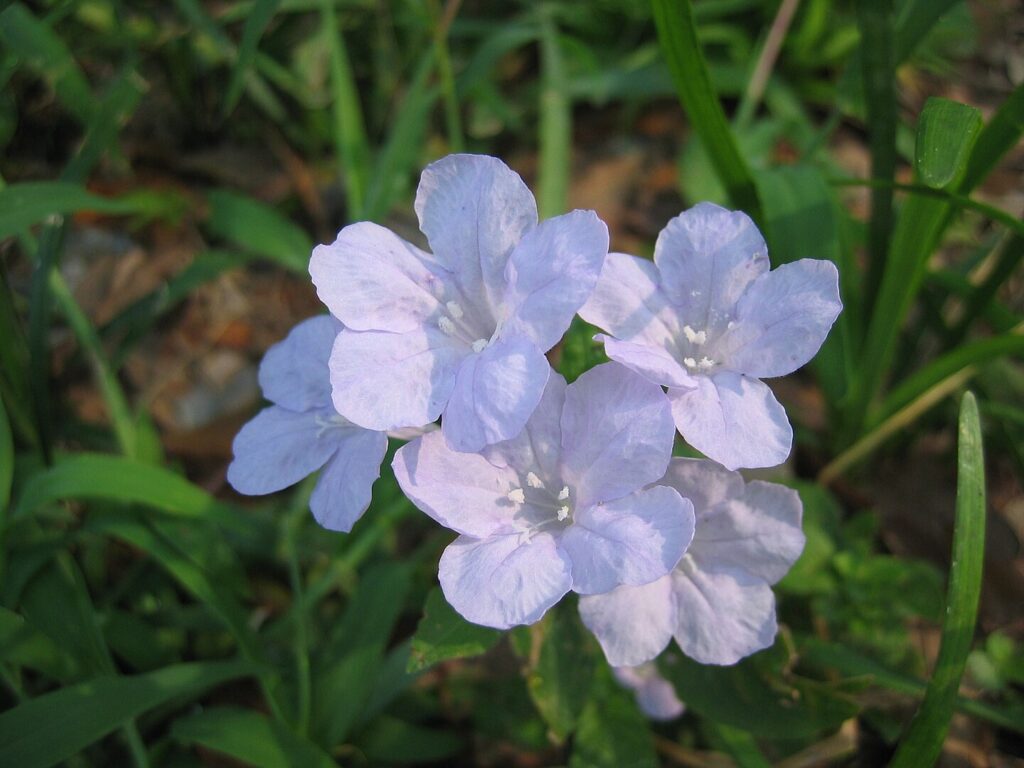
Carolina Wild Petunia produces delicate purple flowers with darker purple centers throughout the warm months, growing 6-24 inches tall and spreading by underground rhizomes. This low-growing perennial has soft, fuzzy leaves and a somewhat sprawling habit.
Native to woodlands, prairies, and disturbed areas, it thrives in partial shade and moist soils.
The flowers attract various butterflies and serve as a host plant for the common buckeye butterfly.
Its spreading nature makes it excellent as a groundcover in naturalized areas or woodland gardens. Unlike its aggressive non-native relative, this native petunia is well-behaved and provides consistent butterfly value. Plant it in areas where its gentle spreading is welcomed.
10. Climbing Aster (Ampelaster carolinianus)
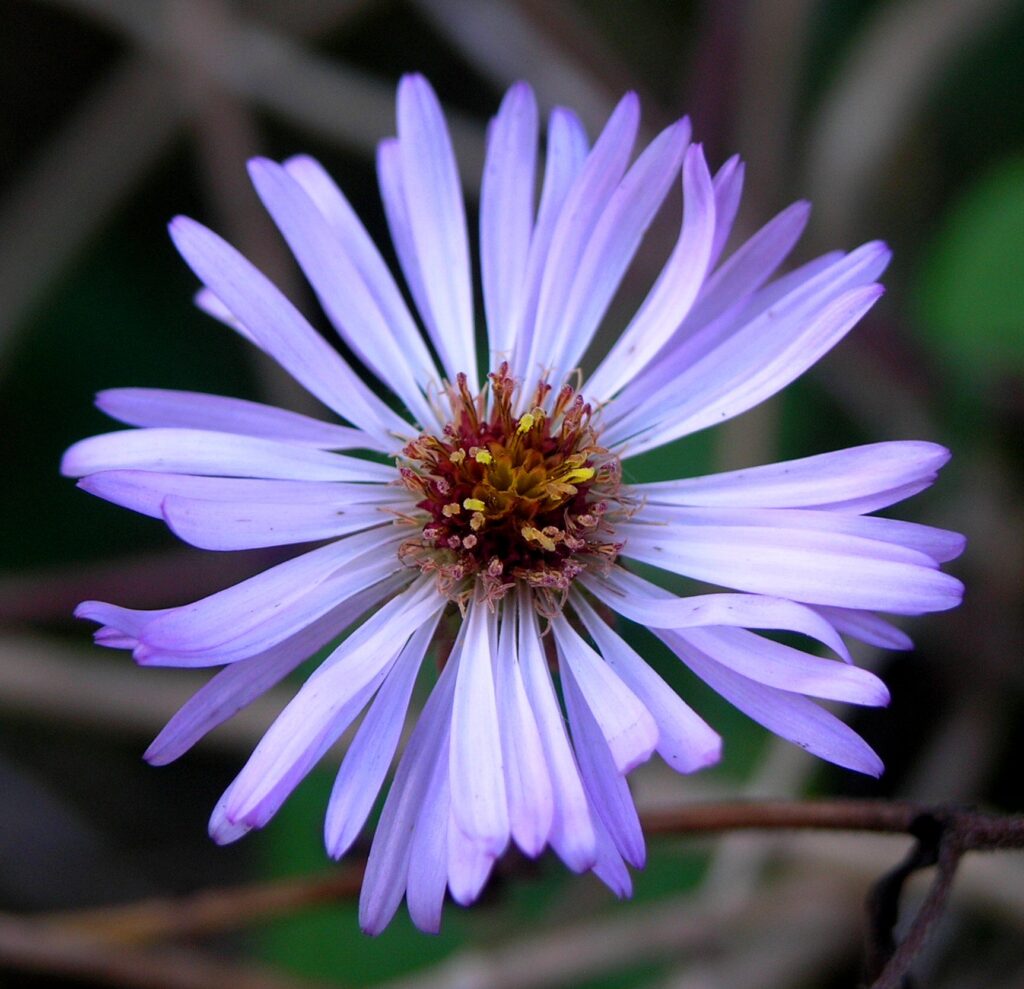
Climbing Aster is a unique vine-like perennial that produces small, white to pale purple flowers in fall, climbing or scrambling 6-15 feet through other vegetation. This unusual aster has heart-shaped leaves and a climbing habit that sets it apart from typical asters.
Native to swamps, floodplains, and moist woodlands, it prefers consistently moist soils and partial shade. The fall flowers provide late-season nectar for butterflies when few other plants are blooming.
Its climbing habit makes it perfect for naturalizing in wild areas where it can scramble through shrubs and trees. This plant is ideal for adding vertical interest and late-season butterfly value to naturalized gardens.
- 2-in-1 Butterfly House and Feeder: Fill the tray with clean water and nectar to provide the butterfly with both a food supply and a comfortable shelter. The garden stake design is more convenient. You don’t need to find strong branches to hang from or worry about being covered by weeds when placed on the ground. You can place the butterfly house anywhere. The three-piece base can stand firmly in the soil without worrying about being affected by bad weather
11. Coastalplain Honeycombhead (Balduina angustifolia)
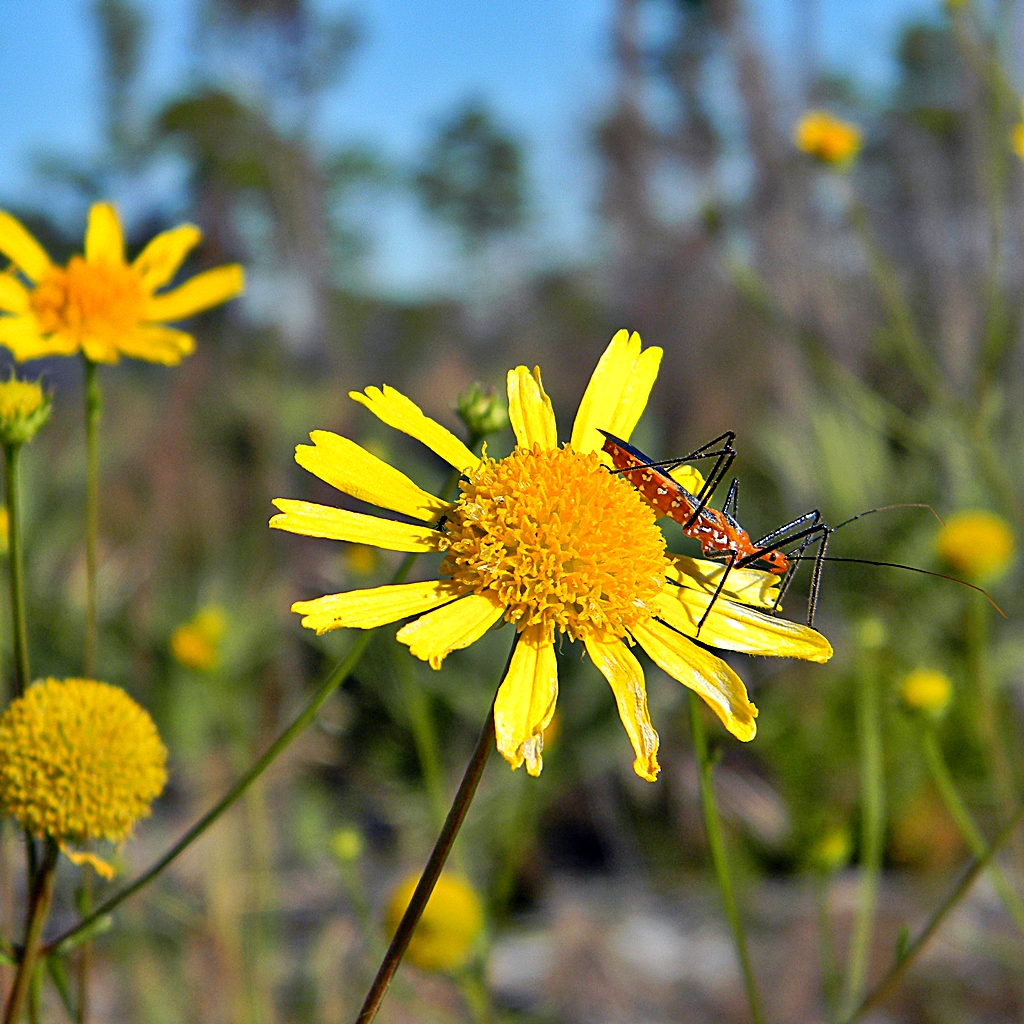
Coastalplain Honeycombhead produces bright yellow, daisy-like flowers with distinctive honeycomb-patterned centers from summer through fall. This upright perennial grows 2-4 feet tall and 1-2 feet wide, with narrow, linear leaves.
Native to pine flatwoods, prairies, and sandy soils, it thrives in well-drained conditions and full sun. The flowers attract various butterflies, especially sulphurs and skippers, and provide seeds for birds.
Its cheerful yellow blooms and upright habit make it excellent for prairie plantings, mixed borders, or naturalized areas. The plant is drought-tolerant once established and provides consistent late-season color. Combine with other yellow-flowered natives like black-eyed Susans for a sunny display.
12. Coral Honeysuckle (Lonicera sempervirens)
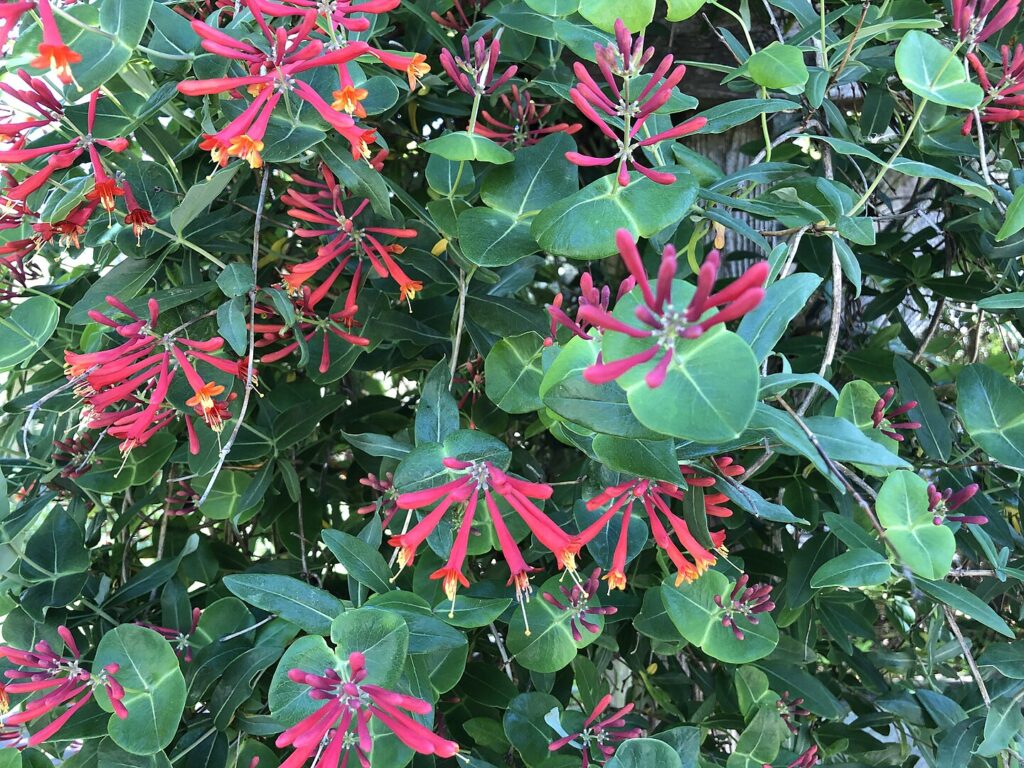
Coral Honeysuckle is a well-behaved native vine that produces clusters of coral-red, trumpet-shaped flowers from spring through fall. This semi-evergreen vine grows 10-20 feet, with blue-green leaves that are perfoliate (joined around the stem) near the flowers.
Native to woodland edges, fencerows, and disturbed areas, it adapts to various soils and light conditions.
The flowers are primarily adapted for hummingbirds but also attract butterflies, especially swallowtails. Red berries in fall provide food for birds.
Unlike invasive non-native honeysuckles, this native species is well-behaved and provides excellent wildlife value. Train it on arbors, fences, or trellises for vertical interest and consistent nectar production.
13. Crossvine (Bignonia capreolata)
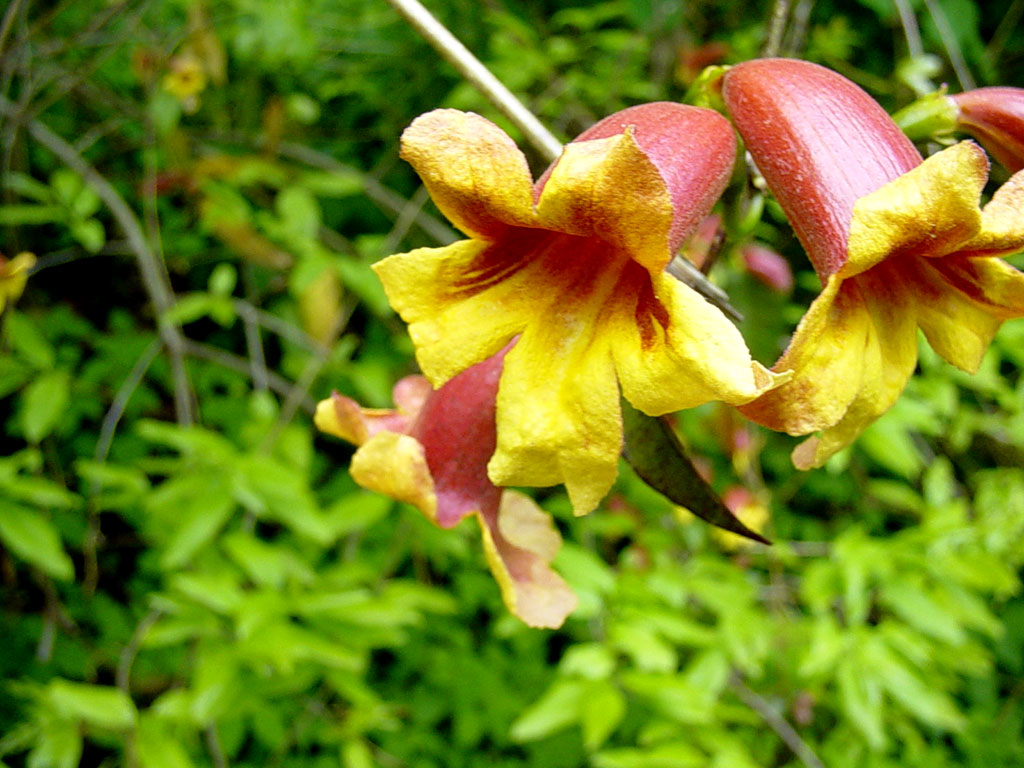
Crossvine is a vigorous evergreen vine that produces clusters of orange-red, trumpet-shaped flowers in spring, growing 30-50 feet with proper support. The compound leaves turn bronze-purple in winter, and the distinctive cross-shaped pattern visible when stems are cut gives the plant its name.
Native to woodlands and forest edges, it thrives in partial shade and moist, well-drained soils.
The flowers attract butterflies, especially swallowtails, and hummingbirds.
Its vigorous growth makes it perfect for covering large fences, arbors, or unsightly structures. The evergreen foliage provides year-round structure and wildlife cover. Plant it where its aggressive growth is welcomed, as it can overwhelm smaller plants.
14. Dense Blazing Star (Liatris spicata)
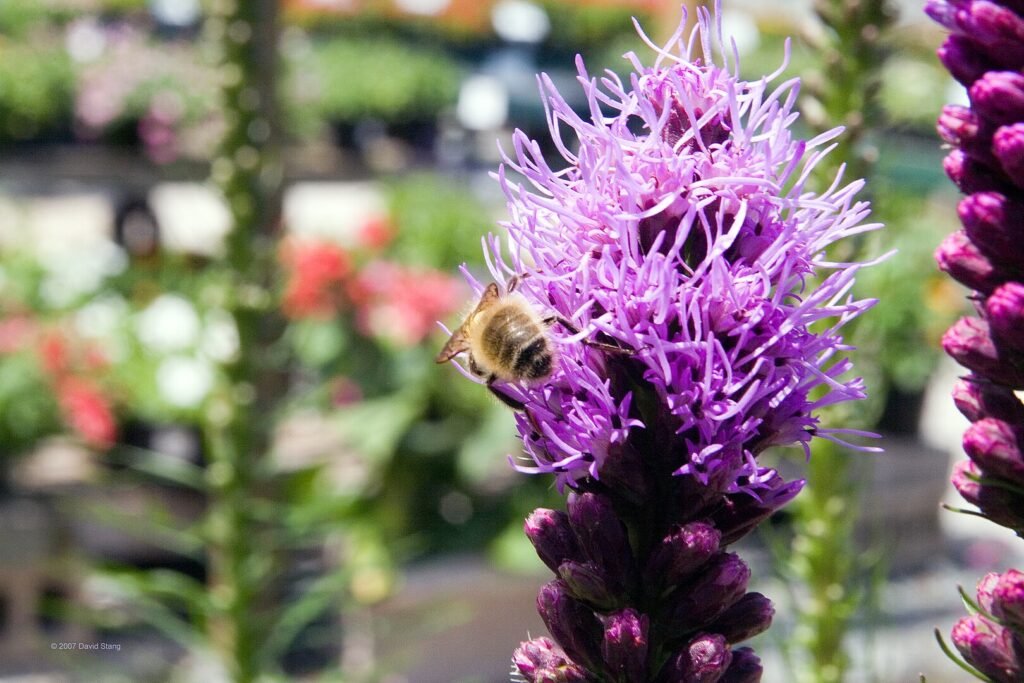
Dense Blazing Star produces dramatic spikes of purple flowers that bloom from top to bottom from late summer through fall, growing 2-4 feet tall and 1-2 feet wide. This upright perennial has narrow, grass-like leaves and develops from underground corms.
Native to wet prairies, marshes, and moist areas, it prefers consistently moist soils and full sun. The flowers are magnets for butterflies, especially monarchs, and provide crucial late-season nectar.
The spikes create excellent cut flowers and the plant naturalizes well in meadow settings. Plant it in masses for maximum impact, and combine with other fall bloomers for extended butterfly activity. The grass-like foliage provides interesting texture when not in bloom.
15. Lanceleaf Coreopsis (Coreopsis lanceolata)
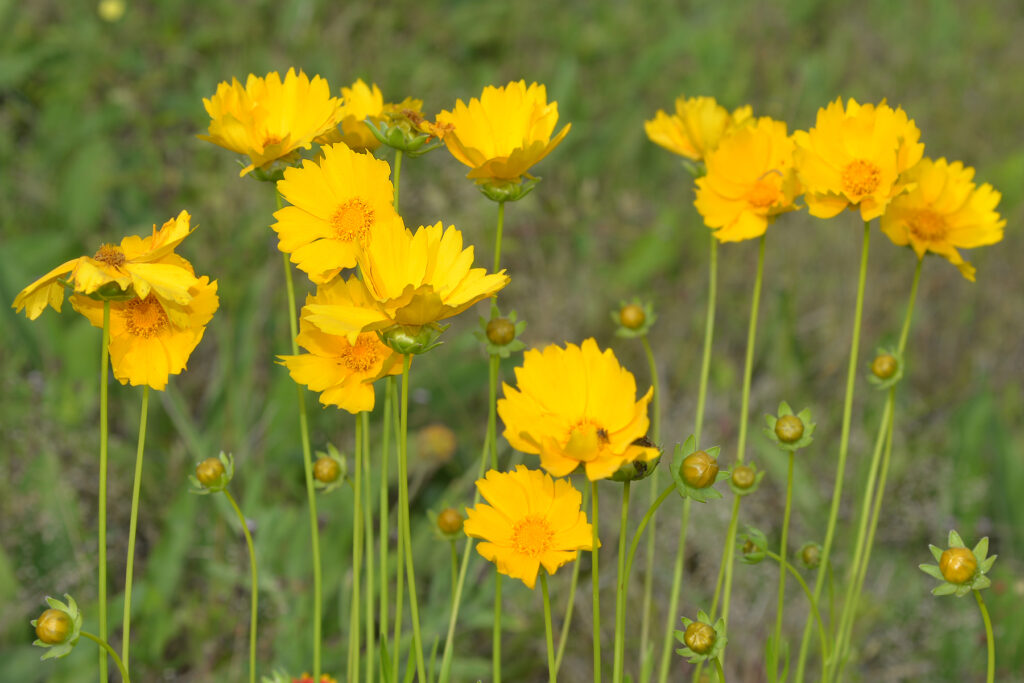
Lanceleaf Coreopsis, Florida’s official State Wildflower, produces cheerful yellow, daisy-like flowers with notched petals from spring through fall, growing 1-2 feet tall and wide. This long-blooming perennial has narrow, lance-shaped leaves and forms spreading clumps.
Native to prairies, roadsides, and disturbed areas, it adapts to various soils but prefers well-drained conditions and full sun. The flowers attract numerous butterflies, especially sulphurs and skippers, and provide extended nectar availability.
Its long blooming period and cheerful appearance make it perfect for cottage gardens, meadow plantings, or mixed borders. Deadheading extends blooming, but allowing some seeds to form provides bird food and natural reseeding.
16. Lyreleaf Sage (Salvia lyrata)
Lyreleaf Sage produces spikes of small, purple flowers in spring, growing 1-2 feet tall and forming rosettes of distinctive lyre-shaped leaves. This perennial has interesting foliage that may be green or purple-tinged, creating textural interest even when not blooming.
Native to woodlands, prairies, and disturbed areas, it thrives in partial shade and moist soils.
The flowers attract butterflies and other pollinators during the crucial spring emergence period.
Its rosette growth habit makes it excellent for groundcover in naturalized areas or woodland gardens. The plant often self-seeds, creating natural colonies. The interesting foliage provides season-long appeal even after flowering.
17. Orange Coneflower (Rudbeckia fulgida)
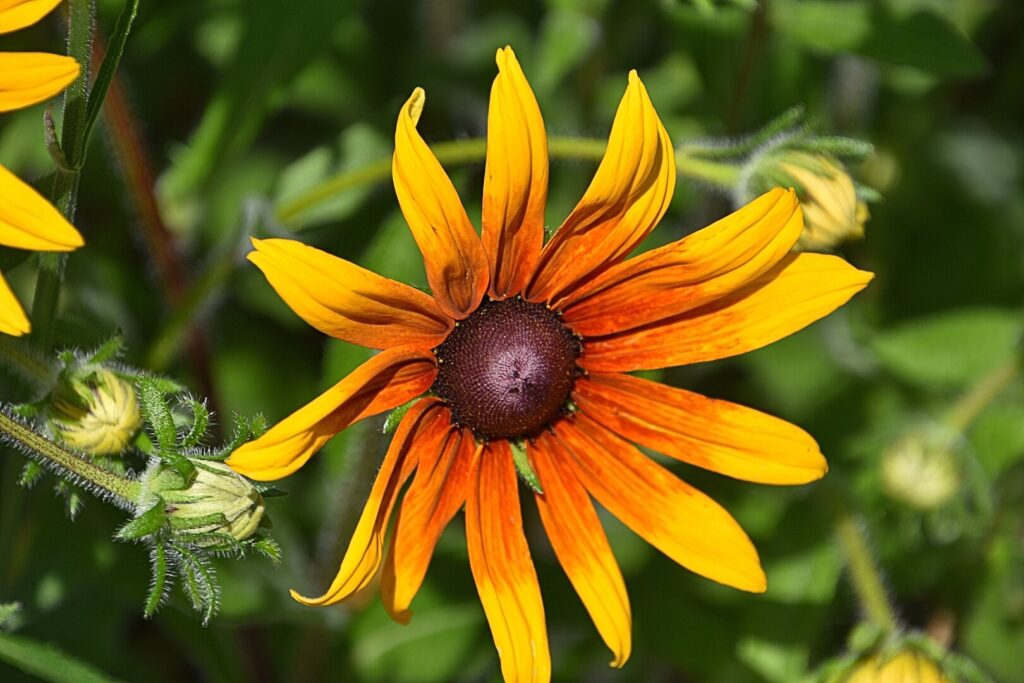
Orange Coneflower produces bright orange-yellow flowers with dark centers from summer through fall, growing 1-3 feet tall and 1-2 feet wide. This sturdy perennial forms clumps and has rough, hairy leaves.
Native to prairies, woodlands, and disturbed areas, it adapts to various soils but prefers well-drained conditions and full sun to partial shade. The flowers attract numerous butterflies and provide seeds for birds.
Its reliable blooming and compact habit make it perfect for borders, mass plantings, or naturalized areas. The plant is drought-tolerant once established and provides consistent color throughout the growing season. Combine with other fall bloomers for extended butterfly activity.
18. Passion Flower (Passiflora incarnata)
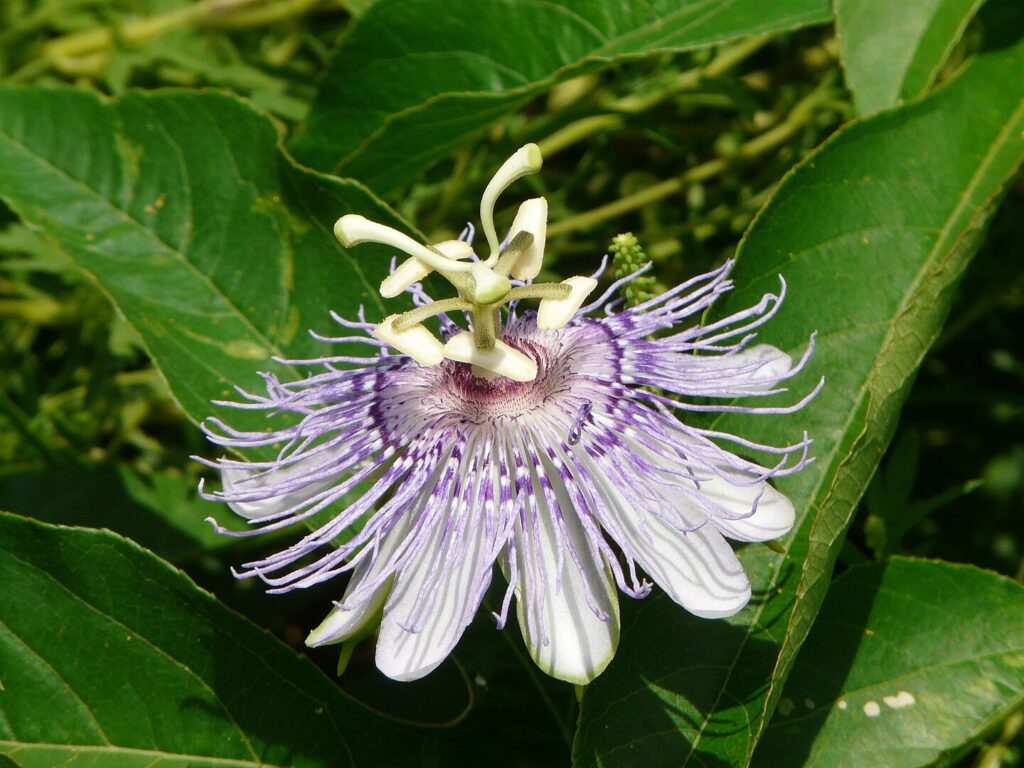
Passion Flower is a fast-growing vine that produces incredibly intricate, purple and white flowers from spring through fall, followed by edible purple fruits. This vigorous vine can grow 15-20 feet in a season, with deeply lobed leaves and tendrils for climbing.
Native to woodland edges, fencerows, and disturbed areas, it adapts to various soils and light conditions.
The flowers are specifically adapted for carpenter bees but also attract butterflies, and the plant serves as the primary host for gulf fritillary, zebra longwing, and variegated fritillary butterflies.
The dramatic flowers and rapid growth make it perfect for covering fences, arbors, or unsightly structures. Plant it where caterpillars feeding on the leaves is welcomed, as this is essential for supporting fritillary butterflies.
- Latticework Arbor: Classic grid-style arbor strong enough for any plant or climbing vine, complementing your surrounding garden or backyard and blending seamlessly with your outdoor decor
- Contemporary Look: Modern grid-style arbor strong enough for any plant or climbing vine, complementing your surrounding garden or backyard and blending seamlessly with your outdoor decor
- Versatile Garden Arbor: Suitable for climbing plants like roses, honeysuckle, clematis, jasmine, or adorned with balloons, tulle, lace, and string lights for a vibrant event atmosphere
19. Pineland Heliotrope (Heliotropium polyphyllum)
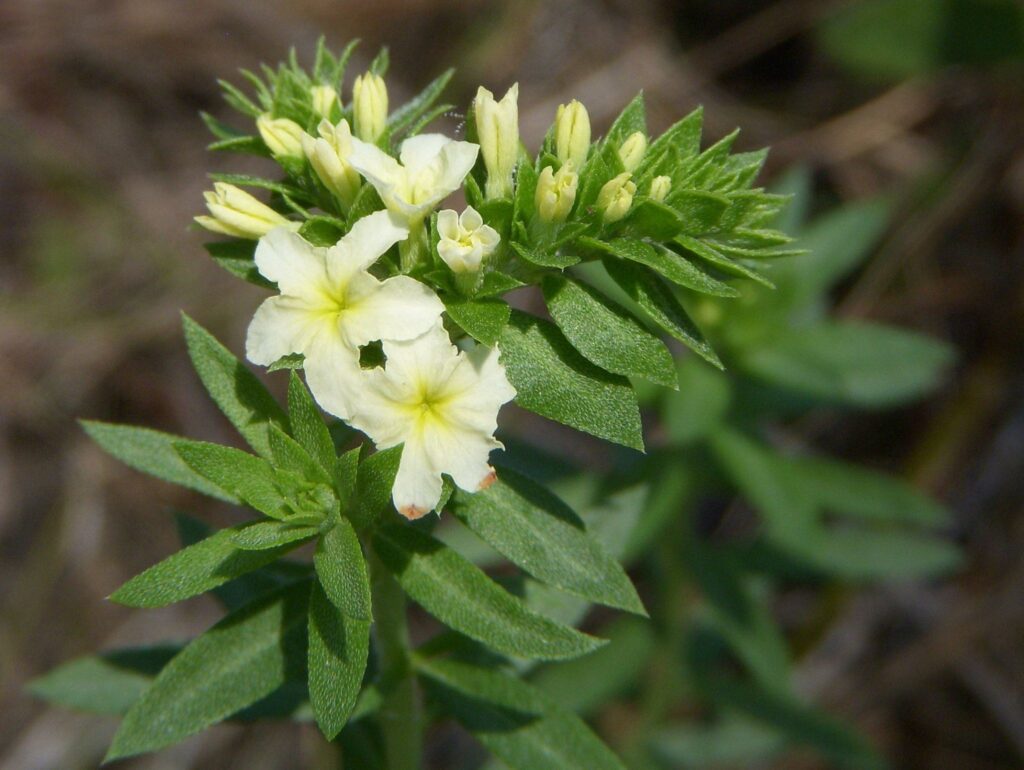
Pineland Heliotrope produces clusters of small, white flowers with a subtle fragrance from spring through fall, growing 1-2 feet tall and wide. This low-growing perennial has small, gray-green leaves and a somewhat sprawling habit.
Native to pine flatwoods, scrub, and sandy soils, it thrives in well-drained conditions and full sun. The flowers attract various butterflies and other small pollinators. Its low growth habit makes it excellent for rock gardens, borders, or naturalized areas with sandy soils.
The plant is extremely drought-tolerant once established and provides consistent nectar throughout the growing season. Its subtle beauty works well in minimalist or desert-style gardens.
20. Purple Coneflower (Echinacea purpurea)
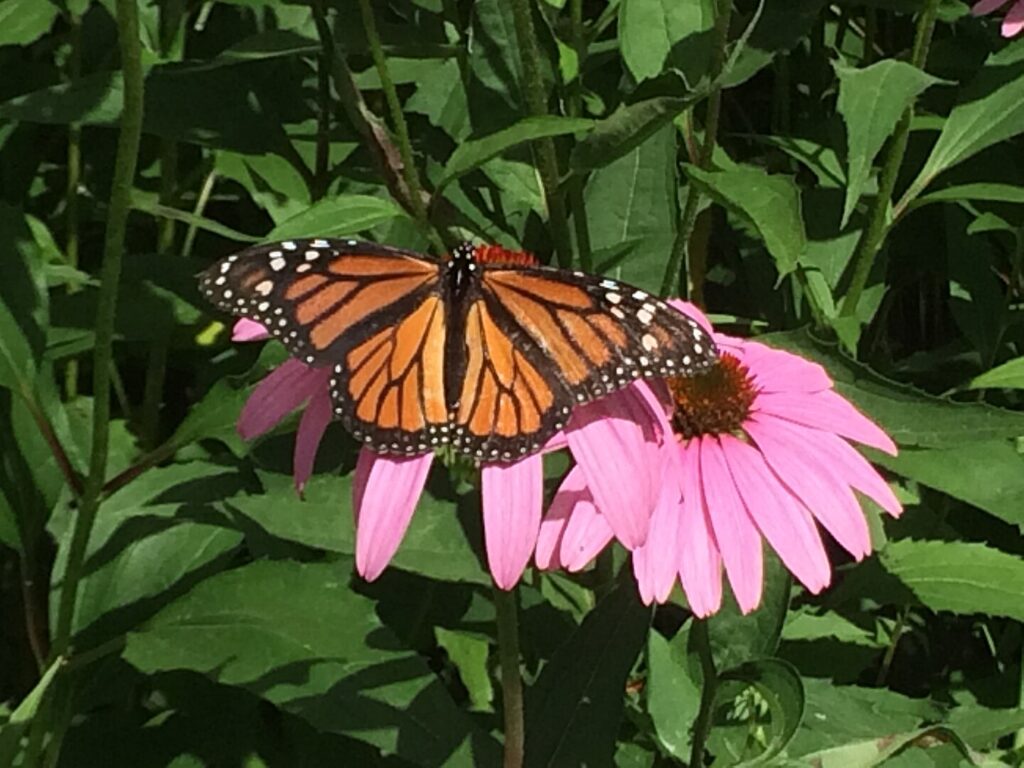
Purple Coneflower produces distinctive purple-pink flowers with prominent orange centers from summer through fall, growing 2-4 feet tall and 1-2 feet wide. This sturdy perennial has rough, lance-shaped leaves and forms clumps that gradually expand.
Native to prairies and open woodlands, it prefers well-drained soils and full sun to partial shade. The flowers attract numerous butterflies, especially fritillaries and skippers, and the seed heads provide food for goldfinches and other birds.
Its architectural form and long blooming period make it perfect for formal borders, cottage gardens, or naturalized areas. The plant is drought-tolerant once established and provides both nectar and seeds for wildlife. Leave seed heads standing through winter for bird food and natural reseeding.
21. Scarlet Sage (Salvia coccinea)
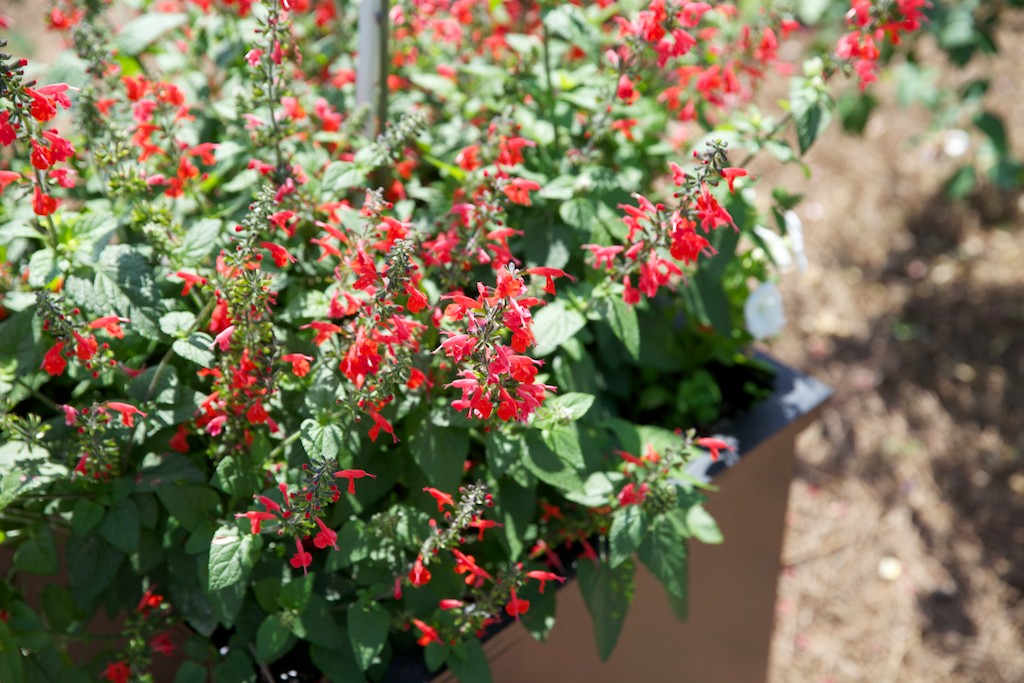
Scarlet Sage, also called Tropical Sage, produces spikes of bright red, tubular flowers from spring through fall, growing 1-3 feet tall and 1-2 feet wide. This annual to short-lived perennial has heart-shaped leaves and an upright, branching habit.
Native to disturbed areas, roadsides, and woodland edges, it thrives in various soils and full sun to partial shade.
The flowers are primarily adapted for hummingbirds but also attract butterflies, especially skippers. Its bright red color and long blooming period make it perfect for adding consistent color to borders or naturalized areas.
The plant self-seeds readily, creating natural colonies. Combine with other red-flowered plants for a vibrant hummingbird and butterfly garden.
22. Slender Blazing Star (Liatris gracilis)
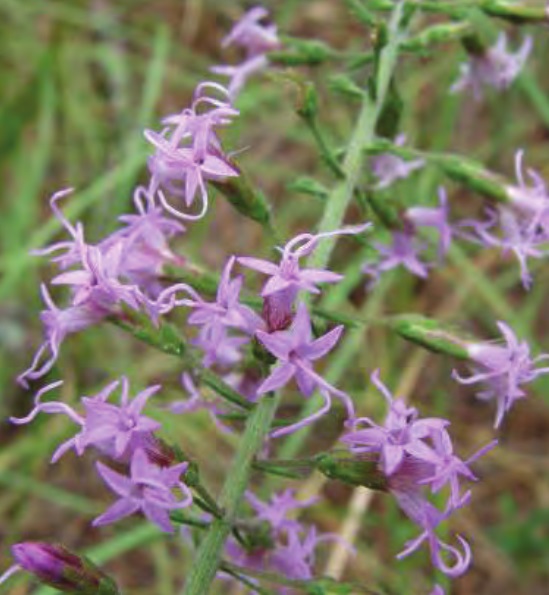
Slender Blazing Star produces airy spikes of purple flowers from late summer through fall, growing 2-3 feet tall and 1 foot wide. This delicate perennial has very narrow, grass-like leaves and a more refined appearance than other blazing stars.
Native to pine flatwoods, prairies, and sandy soils, it thrives in well-drained conditions and full sun. The flowers attract butterflies and provide late-season nectar when few other plants are blooming.
Its delicate appearance makes it perfect for naturalized areas or mixed with other prairie plants. The plant is drought-tolerant once established and provides consistent late-season color. Its refined habit works well in formal gardens as well as wild areas.
23. Spanish Needles (Bidens alba)
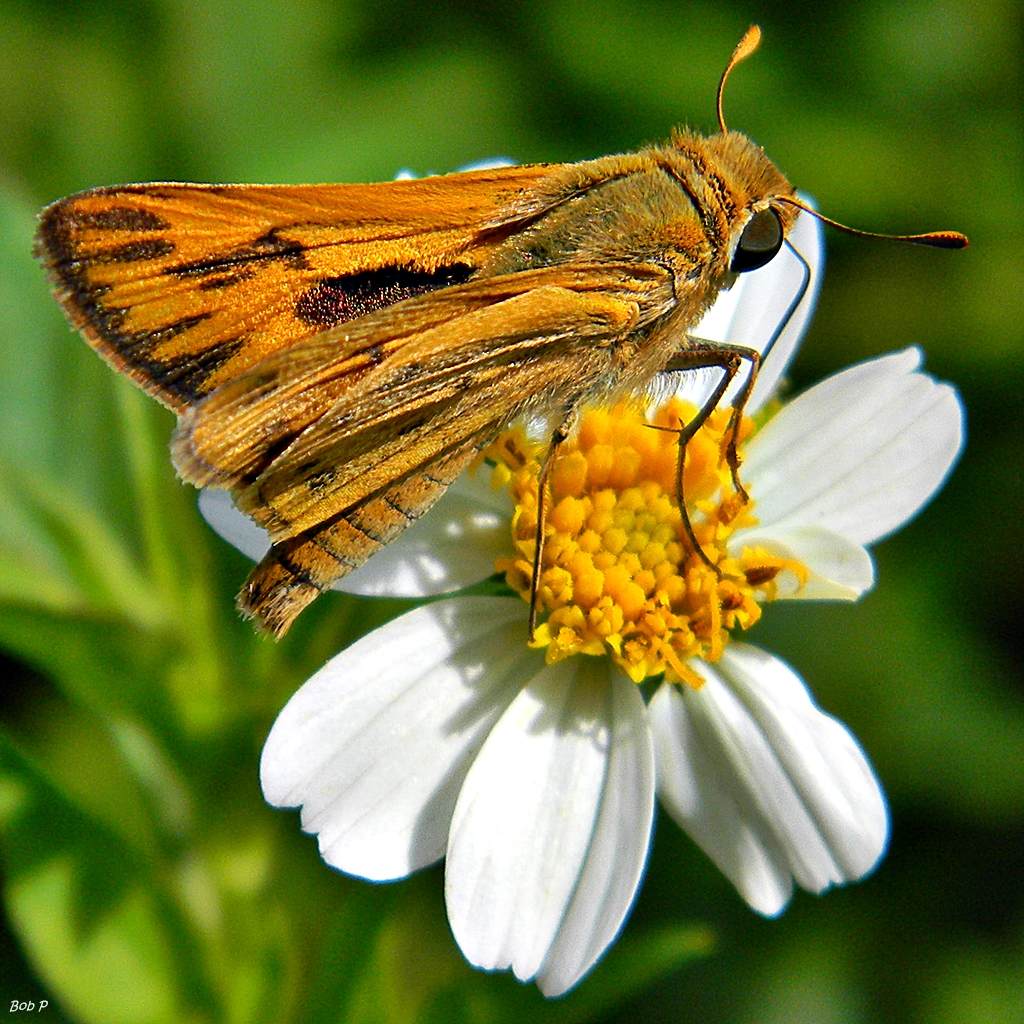
Spanish Needles produces small, white, daisy-like flowers nearly year-round in South Florida, growing 1-3 feet tall and wide. This annual has compound leaves and a somewhat weedy appearance but incredible wildlife value.
Native to disturbed areas, roadsides, and forest edges throughout Florida, it thrives in various soils and conditions. The flowers are exceptionally attractive to butterflies and other pollinators, providing consistent nectar when other plants aren’t blooming.
Its weedy appearance and aggressive self-seeding make it best suited for naturalized areas or wildlife gardens. The seeds provide food for birds, and the plant serves as host for several butterfly species. Embrace its wild nature in areas where consistent butterfly activity is more important than formal appearance.
24. Spotted Bee Balm (Monarda punctata)
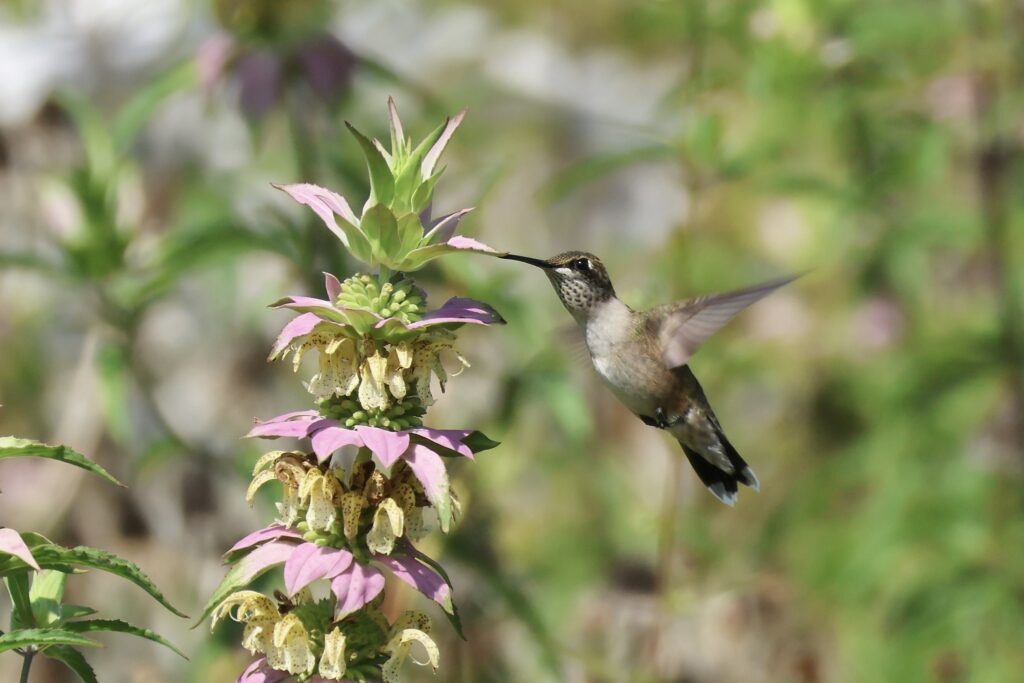
Spotted Bee Balm produces unique, two-lipped flowers in whorls around the stem, with pale yellow petals spotted with purple, blooming from summer through fall. This aromatic perennial grows 1-3 feet tall and 1-2 feet wide, with narrow, toothed leaves that release a minty fragrance when crushed.
Native to prairies, pine flatwoods, and sandy soils, it thrives in well-drained conditions and full sun. The flowers attract various butterflies, especially skippers, and the plant serves as a host for several moth species.
Its unusual flower form and aromatic foliage make it perfect for herb gardens, prairie plantings, or naturalized areas. The plant self-seeds readily and provides both nectar and host plant value. The aromatic leaves can be used for tea.
25. Spurred Butterfly Pea (Centrosema virginianum)
Spurred Butterfly Pea is a delicate vine that produces purple, pea-like flowers from spring through fall, climbing 3-6 feet through other vegetation. This herbaceous perennial has compound leaves with three leaflets and tendrils for climbing.
Native to pine flatwoods, prairies, and woodland edges, it thrives in well-drained soils and full sun to partial shade. The flowers attract butterflies, especially sulphurs and skippers, and the plant serves as a host for several butterfly species.
Its delicate climbing habit makes it perfect for naturalizing in wild areas where it can scramble through grasses and shrubs. The plant fixes nitrogen in the soil, benefiting surrounding plants. Its subtle beauty works well in naturalized gardens.
26. Stoke’s Aster (Stokesia laevis)
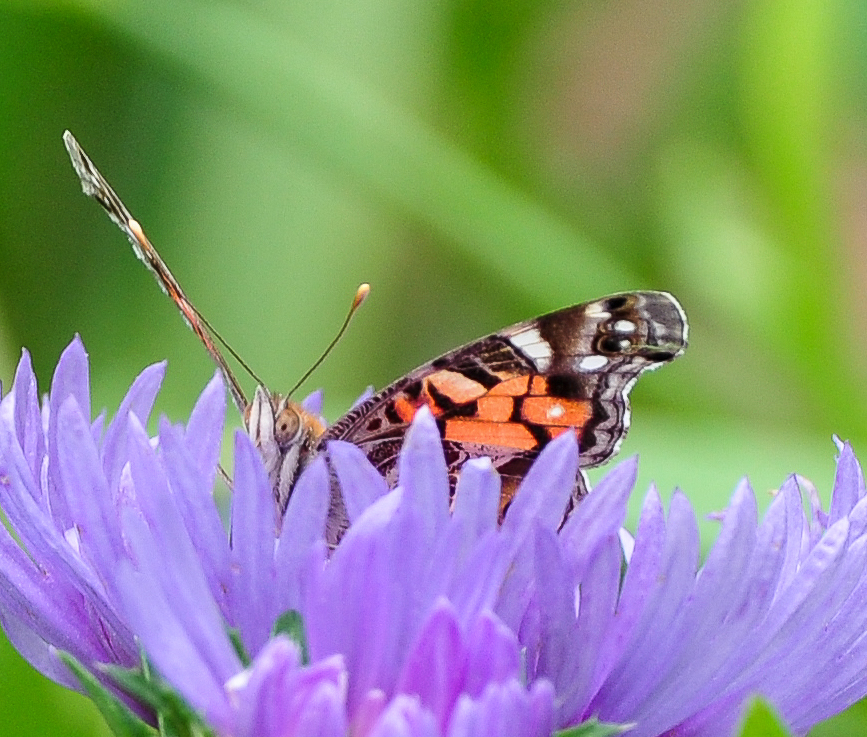
Stoke’s Aster produces large, showy flowers with fringed petals in shades of blue, purple, or white from summer through fall, growing 1-2 feet tall and wide. This distinctive perennial has narrow, evergreen leaves and forms clumps that gradually expand.
Native to pine flatwoods, prairies, and moist areas, it thrives in well-drained to slightly moist soils and full sun to partial shade. The large flowers attract various butterflies and provide excellent nectar sources.
Its showy blooms and compact habit make it perfect for borders, rock gardens, or naturalized areas. The evergreen foliage provides year-round structure, and the plant is relatively drought-tolerant once established. The unique flower form adds interesting texture to butterfly gardens.
27. Swamp Milkweed (Asclepias incarnata)
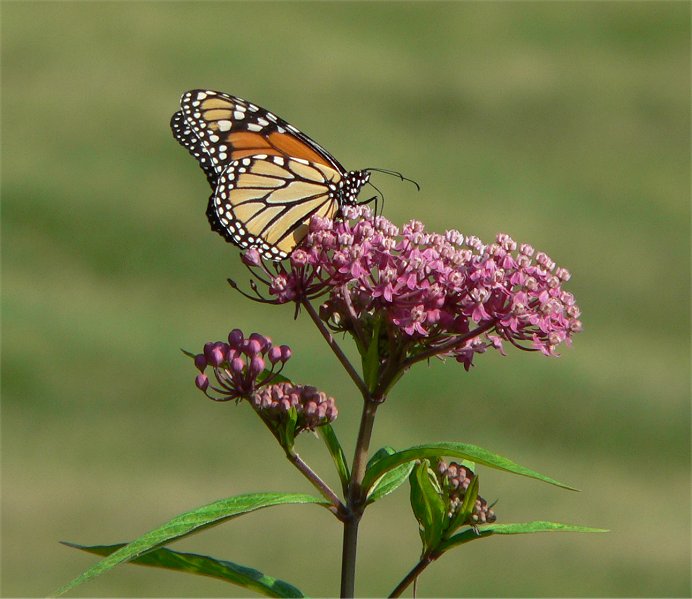
Swamp Milkweed produces clusters of fragrant, pink to rose-colored flowers from summer through fall, growing 3-5 feet tall and 1-2 feet wide. This upright perennial has narrow, lance-shaped leaves and thrives in consistently moist soils.
Native to marshes, wet prairies, and pond edges, it prefers full sun and wet to moist conditions. Like other milkweeds, it serves as a host plant for monarch butterflies and attracts numerous other butterflies for nectar.
The fragrant flowers and tall stature make it perfect for rain gardens, pond margins, or the back of moist borders. Plant it in masses for maximum impact, and remember that monarch caterpillars may defoliate plants. The plant’s preference for moisture makes it ideal for areas with poor drainage.
28. Swamp Sunflower (Helianthus angustifolius)
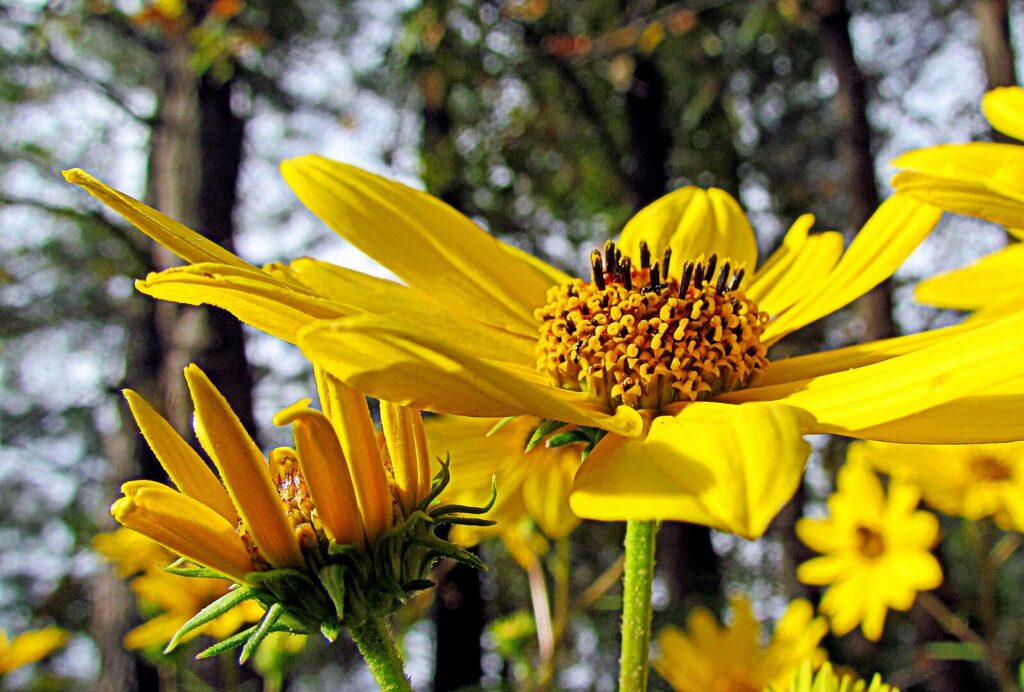
Swamp Sunflower produces bright yellow flowers with dark centers from late summer through fall, growing 4-8 feet tall and 2-3 feet wide. This tall perennial has narrow, rough leaves and forms colonies by underground rhizomes.
Native to wet prairies, marshes, and moist areas, it thrives in consistently moist soils and full sun. The flowers attract various butterflies and provide seeds for birds.
Its tall stature and late-season bloom make it perfect for the back of borders, naturalized areas, or screening. The plant can be aggressive in ideal conditions, so plant it where spreading is welcomed. The bright yellow blooms provide crucial late-season nectar when monarchs are migrating.
29. Trumpet Creeper (Campsis radicans)
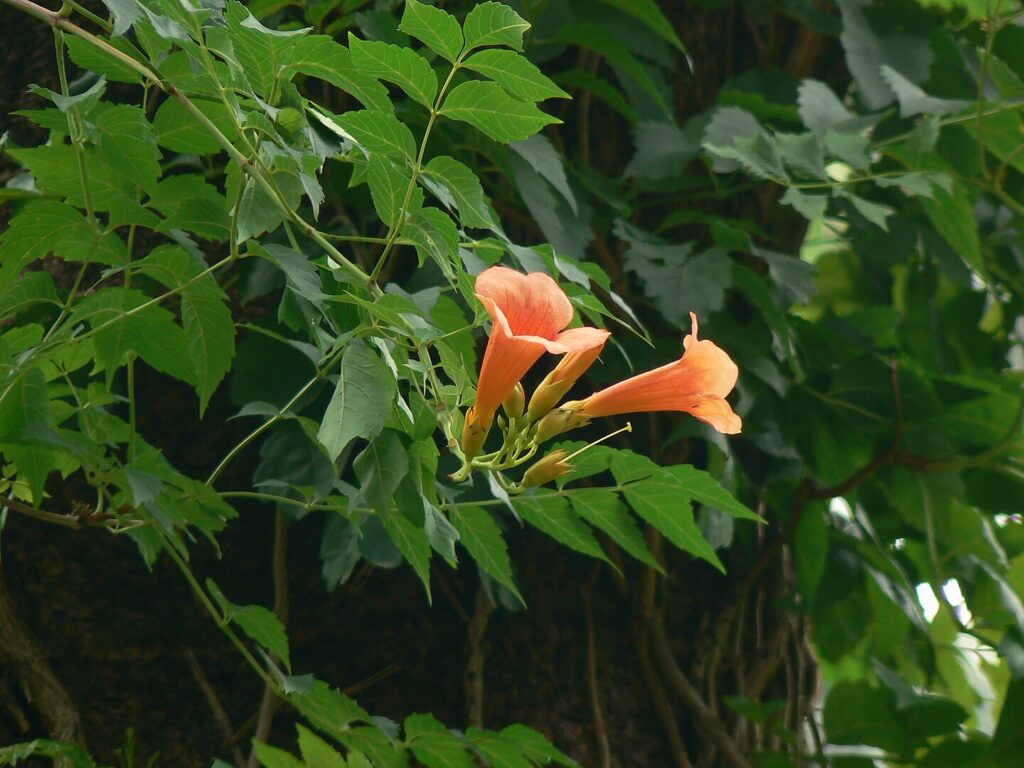
Trumpet Creeper is a vigorous vine that produces clusters of orange-red, trumpet-shaped flowers from summer through fall, growing 30-40 feet with proper support. This deciduous vine has compound leaves and attaches to surfaces with aerial rootlets.
Native to woodland edges, fencerows, and disturbed areas, it adapts to various soils and light conditions. The flowers are primarily adapted for hummingbirds but also attract butterflies, especially swallowtails.
Its aggressive growth makes it perfect for covering large structures, but it can be invasive in ideal conditions. Plant it where its vigorous nature is welcomed, such as covering unsightly fences or buildings. The orange flowers provide consistent nectar throughout the growing season.
30. White Twinevine Milkweed (Sarcostemma clausum)
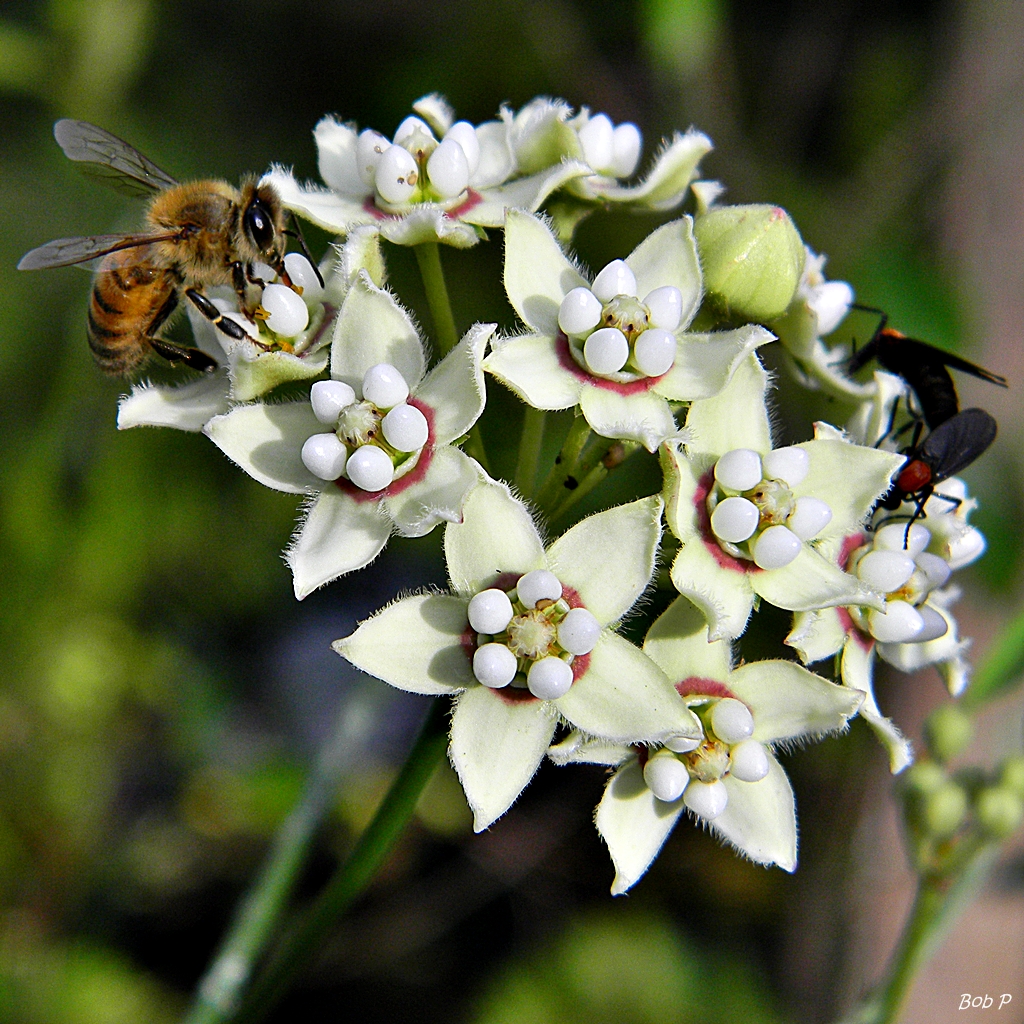
White Twinevine Milkweed is a climbing vine that produces clusters of small, white, star-shaped flowers from spring through fall, growing 6-10 feet long. This slender vine has narrow, linear leaves and a twining habit.
Native to pine flatwoods, scrub, and sandy soils, it thrives in well-drained conditions and full sun to partial shade. Like other milkweeds, it serves as a host plant for monarch butterflies and attracts other butterflies for nectar.
The vine’s delicate appearance and climbing habit make it perfect for naturalizing in wild areas where it can climb through shrubs and trees. Its drought tolerance and consistent blooming make it valuable for sandy, difficult sites. The plant provides both host and nectar value for butterflies in a unique climbing form.
31. Whorled Milkweed (Asclepias verticillata)
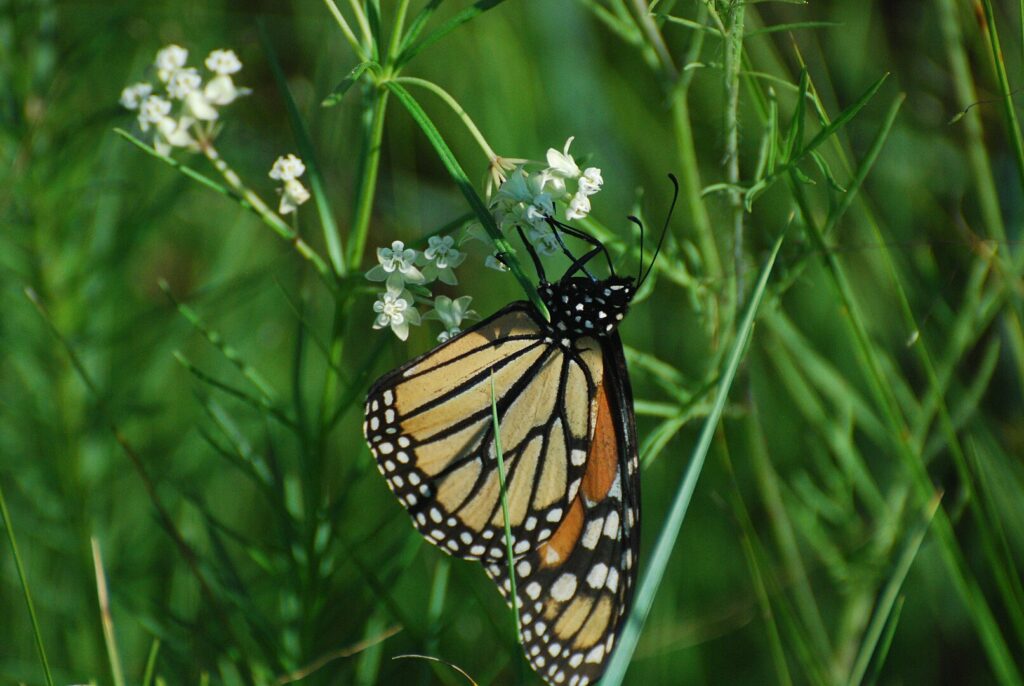
Whorled Milkweed produces small clusters of white flowers from spring through fall, growing 1-2 feet tall and wide. This delicate perennial has narrow, needle-like leaves arranged in whorls around the stem, creating fine textural interest.
Native to prairies, pine flatwoods, and sandy soils, it thrives in well-drained conditions and full sun. Asclepias verticillata (Whorled Milkweed) is a hardy, upright perennial with fine, needle-like leaves. Like other milkweeds, it serves as a host plant for monarch butterflies and attracts numerous other butterflies for nectar.
Its delicate appearance and fine texture make it perfect for naturalized areas, rock gardens, or mixed with other prairie plants. The plant is extremely drought-tolerant once established and provides consistent nectar throughout the growing season. Its subtle beauty works well in minimalist or naturalistic gardens.
- [Comfortable Armrest & Backrest] – Enjoy ultimate comfort with our outdoor garden bench featuring meticulously designed armrests and a supportive backrest, providing a relaxing seating experience.
- Garden Decor: This pair trellis features 6 lifelike butterflies perch on the florets with bronze powder coating, and it comes with ornate leaf curling design which encourages your climbing vines and flowers to flourish. The butterflies are finished with a charming gradient effect
- GARDEN BENCH: Outdoor garden bench designed with lovely butterflies perfect for your yard, patio, deck, or garden
Creative Design Tips for Using Native Florida Butterfly Plants
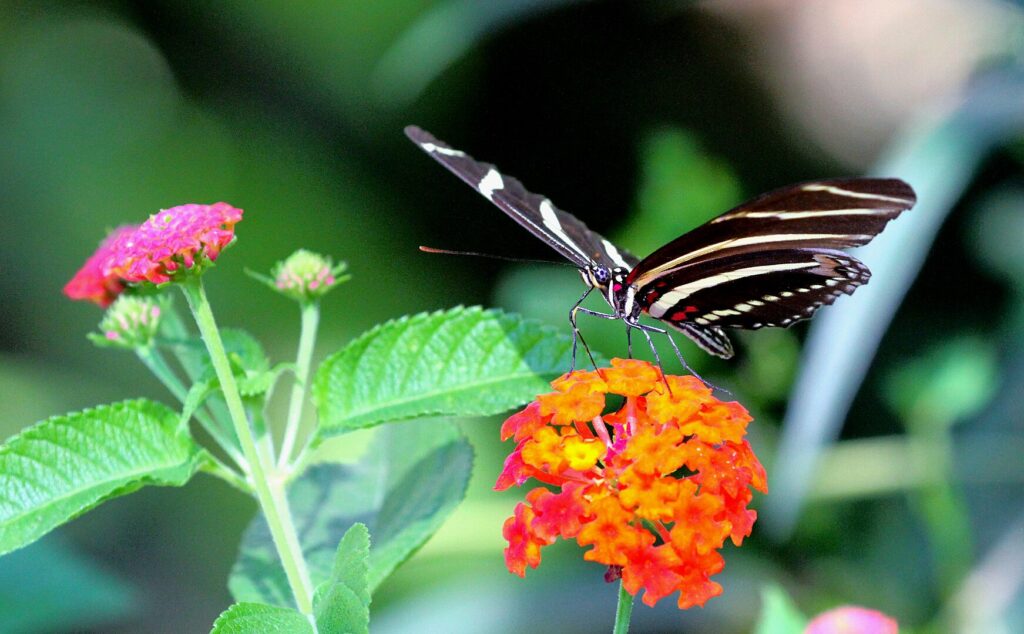
Creating a successful butterfly garden requires thoughtful planning that considers both adult nectar needs and caterpillar host requirements. Group plants in masses rather than single specimens to create visual impact and provide abundant resources for butterflies.
Plant Many Layers
Layer plants by height, placing taller species like blazing stars and swamp sunflowers in the back, medium-height plants like coneflowers and asters in the middle, and low-growing species like wild petunias and heliotrope in front.
Plant for Year-Round Bloom
Consider bloom succession by combining plants that flower at different times, ensuring nectar availability from early spring through late fall. Early bloomers like Carolina jessamine and lyre-leaf sage provide crucial resources for emerging butterflies, while late-season bloomers like asters and blazing stars support migrating monarchs and other fall butterflies.
Provide Diverse Microclimates
Create habitat diversity by incorporating both sun and shade plants, wet and dry areas, and various soil types. This approach supports the widest range of butterfly species and their varying needs. Include host plants like milkweeds and passion vines even if caterpillars may temporarily defoliate them – this damage is essential for supporting butterfly reproduction and indicates a healthy ecosystem.
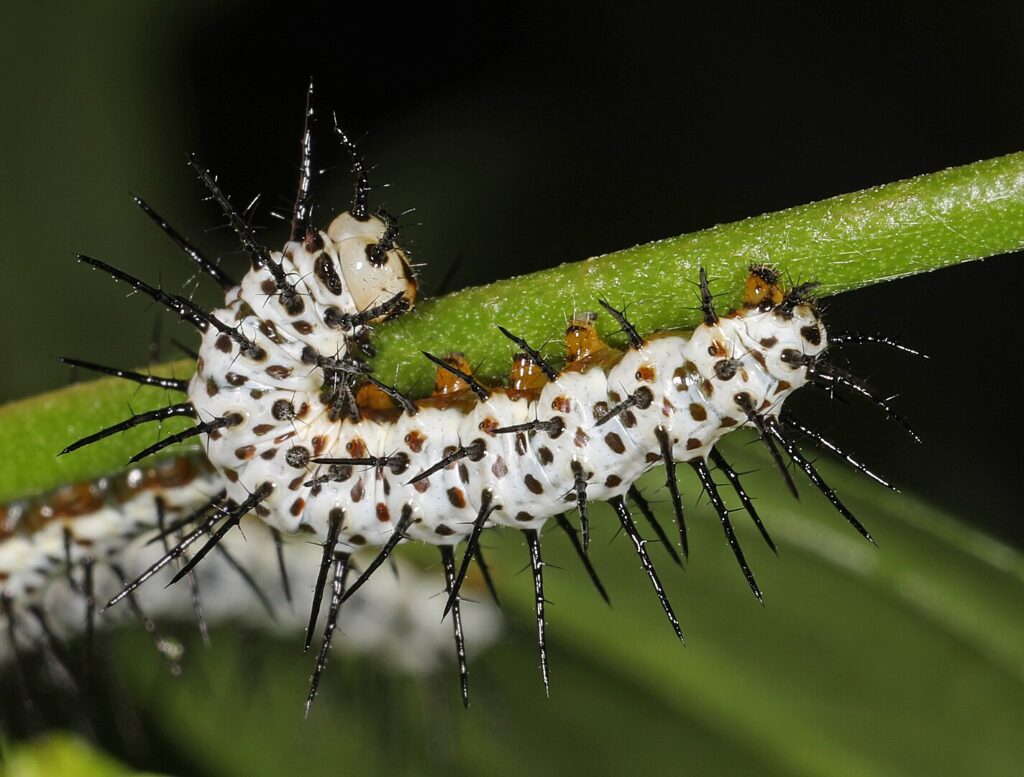
Design with natural drift patterns, allowing aggressive spreaders like blue mistflower and Spanish needles to naturalize in appropriate areas while containing them with barriers or regular maintenance where needed. Use vines like coral honeysuckle and crossvine to add vertical interest and create multi-layered habitats that support different butterfly species and their varying feeding preferences.
Go Wild
Remember that butterfly gardens should embrace a slightly wild appearance, as perfect maintenance often eliminates the diverse habitats that butterflies need for feeding, reproduction, and shelter. Allow some areas to remain undisturbed through winter to provide overwintering sites for butterflies and beneficial insects.
Featured Image via By Intermountain Forest Service, USDA Region 4 Photography – Horsemint with Butterfly, Public Domain, Link












